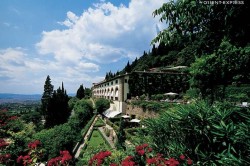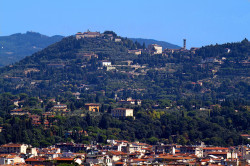 Besisvečiuojant Florencijoje būtina užsukti ir į visai šalia įsikurusį Fiesole miestelį – Florencijos „stogą“. Pirmiausia todėl, iš jo atsiveria puiki Florencijos ir viso slėnio panorama. Tačiau čia netrūksta ir kitų įdomybių.
Besisvečiuojant Florencijoje būtina užsukti ir į visai šalia įsikurusį Fiesole miestelį – Florencijos „stogą“. Pirmiausia todėl, iš jo atsiveria puiki Florencijos ir viso slėnio panorama. Tačiau čia netrūksta ir kitų įdomybių.
Istorija čia skaičiuojama nuo IV a. pr. Kr. , kai Fiesole buvo vienas svarbiausių regiono etruskų miestų, vadintas Vipsul. 90-aisiais pr. Kr. gyvenvietė buvo pervadinta, o joje buvo visi romėnų miestui būdingi pastatai – forumas, teatras, kelios šventyklos, termos, akropolis. Augant Florencijos galiai atsirado „trintis“, tad pirmą kartą florentiečiai Fiesole nuniokojo 1010 metais. Vėliau Fiesole ir jos apylinkės tapo prabangių vilų buveine, čia rūmus statė net ir Medici šeimos nariai. O nuo XVII amžiaus čia mielai apsigyvendavo į Florenciją atvykę užsieniečiai menininkai ar mokslininkai.
Kaip nuvykti
Pats paprasčiausias būdas nuvykti į Fiesole – Florencijos viešasis transportas (autobusas nr. 7 išvyksta iš Piazza San Marco aikštės Florencijos centre). Autobusai kursuoja nuo ankstyvo ryto iki vidurnakčio. Važiavimo bilietą galite įsigyti „Tabacchi“ kioskelyje arba pas vairuotoją autobuse.
Pakeliui į Fiesole galite mėgautis puikia panorama – autobusas važiuoja Florencijos priemiesčių vilų apsuptomis į viršų kylančiomis gatvėmis. Apsuptos kiparisų, saugomos aukštų vartų, nepaprasto grožio vilos džiugina akį. Išlipus centrinėje Fiesole aikštėje belieka pasirinkti, ką norite išvysti.
Archeologinė zona. Didžiulėje žaliuojančioje teritorijoje galite aplankyti įvairių laikotarpių archeologinius paminklus – romėnų teatrą, kuriame vasarą iki šiol rengiami įspūdingi koncertai, etruskų-romėnų šventyklą, romėnų termų liekanas. Čia įsikūręs ir archeologijos muziejus. 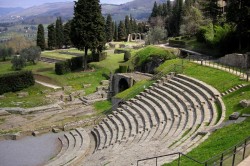
Muziejai. Museo Bardini saugo nemažai XIII-XV amžiaus flotentietiškosios tapybos pavyzdžių ir terakotos dirbinius.
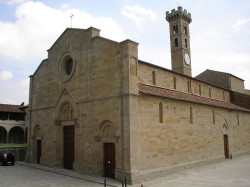 Šventovės. Cattedrale di S. Romolo pradėta statyti 1028-aisiais. Fiesolės katedra romaninio stiliaus, viduje dekoras kuklus, vienas įdomiausių objektų – kripta. Katedroje visuomet tvyro prieblanda, o vasarą gera pasislėti nuo išorėje tvyrančio karščio. Badia fiesolana – Fiesolės abatija pastatyta XI a. pradžioje, dėmesio vertas renesansinis vienuolyno kiemas. Chiesa e convento di San Domenico – bažnyčia ir vienuolynas baigti statyti 1435 m., čia galima rasti Beato Angelico ir Antonio da Sangallo vyresniojo darbų.
Šventovės. Cattedrale di S. Romolo pradėta statyti 1028-aisiais. Fiesolės katedra romaninio stiliaus, viduje dekoras kuklus, vienas įdomiausių objektų – kripta. Katedroje visuomet tvyro prieblanda, o vasarą gera pasislėti nuo išorėje tvyrančio karščio. Badia fiesolana – Fiesolės abatija pastatyta XI a. pradžioje, dėmesio vertas renesansinis vienuolyno kiemas. Chiesa e convento di San Domenico – bažnyčia ir vienuolynas baigti statyti 1435 m., čia galima rasti Beato Angelico ir Antonio da Sangallo vyresniojo darbų.
Apžvalgos aikštelė. Iš Fiesole esančios apžvalgos aikštelės atsiveria puiki Florencijos ir viso slėnio panorama. Iki jos iš centrinės Fiesole aikštės veda status akmenimis grįstas kelias. Grožintis atsivėrusiu vaizdu užnugaryje stovi Convento di San Francesco (liet. šv. Pranciškaus vienuolynas). Vienuolynas buvo pastatytas 1399 m.
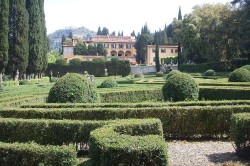 Vilos ir sodai. Villa Medici Fiesole kalvose yra viena iš gražiausių, seniausių ir geriausiai išlikusių, tačiau mažiau žinomų šeimos vilų. XIV a. vid. pastatyta buvo pirmoji tikra renesansinė užmiesčio vila, o ne vienas iš daugelio tipiškų užmiesčio pastatų. Villa Peyron ir jos parkas dažnai minimi tarp gražiausių Italijos parkų. Castello di Vincigliata primena tikrą pasakų pilį, apsuptą žaliuojančio parko (pilies istorija skaičiuojama nuo XI amžiaus). Villa Nieuwenkamp priklausė Fiesolės abatijai, o XIX amžiuje buvo paversta prabangia rezidencija. Čia XX a. pirmoje pusėje kurį laiką gyveno olandų dailininkas Wynand Otto Jan Nieuwenkamp. Kitos žavingos vilos: Castel di Poggio, Villa di Maiano, Villa San Michele, Villa le Balze, Villa Schifanoia.
Vilos ir sodai. Villa Medici Fiesole kalvose yra viena iš gražiausių, seniausių ir geriausiai išlikusių, tačiau mažiau žinomų šeimos vilų. XIV a. vid. pastatyta buvo pirmoji tikra renesansinė užmiesčio vila, o ne vienas iš daugelio tipiškų užmiesčio pastatų. Villa Peyron ir jos parkas dažnai minimi tarp gražiausių Italijos parkų. Castello di Vincigliata primena tikrą pasakų pilį, apsuptą žaliuojančio parko (pilies istorija skaičiuojama nuo XI amžiaus). Villa Nieuwenkamp priklausė Fiesolės abatijai, o XIX amžiuje buvo paversta prabangia rezidencija. Čia XX a. pirmoje pusėje kurį laiką gyveno olandų dailininkas Wynand Otto Jan Nieuwenkamp. Kitos žavingos vilos: Castel di Poggio, Villa di Maiano, Villa San Michele, Villa le Balze, Villa Schifanoia. 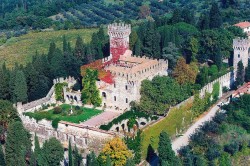
Aktyvus turizmas
Fiesole – puiki vieta aktyviam turizmui. Tad siūlome jums išbandyti vieną iš pasivaikšiojimų užmiestyje, pasimėgauti kaimo vaizdais ir gamta, o taip pat susipažinti su įdomiais, tačiau turistų retai atrandamais objektais.
Maršrutas „Etruskų pėdsakais“ pristato etruskų palikimą už archeologinės zonos ribų. Mūrai, laidojimo vietos ir paslaptingi ženklai primena didžią etruskų Fiesole praeitį.
Maršrutas „Senaisiais kaimo keliais“ nukelia keliautojus laiku į praeitį, kur žemdirbiai darbavosi senoviniais būdais. Seni akmenimis grįsti užmiesčio keliai vingiuoja sodais ir dovanoja puikius gamtos vaizdus.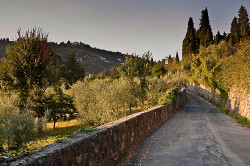
Maršrutas „Orchidėjų pasaulyje“. Ne vienas turistas nustemba sužinojęs, kad Fiesoleje galima pamatyti šimtus natūralioje aplinkoje augančių orchidėjų. Įvairių dydžių ir spalvų gėlės užburia čia apsilankiusius.
Maršrutas „Montececeri parkas ir jo olos“. Žymiausių Florencijos architektų Brunelleschi, Vasari, Michelangelo ar Cellini ypač mėgiama uoliena, vadinama „Pietra Serena“ dažnai randama senuosiuose miesto rūmuose. Tad šis maršrutas – puiki proga pažinti ją ir vietas, iš kurių ši uoliena pasiekdavo prabangiausias Florencijos vilas. Montececeri taip pat dažnai vadinamas „luogo Leonardiano“, t.y. Leonardo vieta. Ne veltui, mat pirmaisiais XVI amžiaus metais Leonardo da Vinci čia turėjo žemės, kurioje bandydavo paties kurtas skraidančias mašinas.


